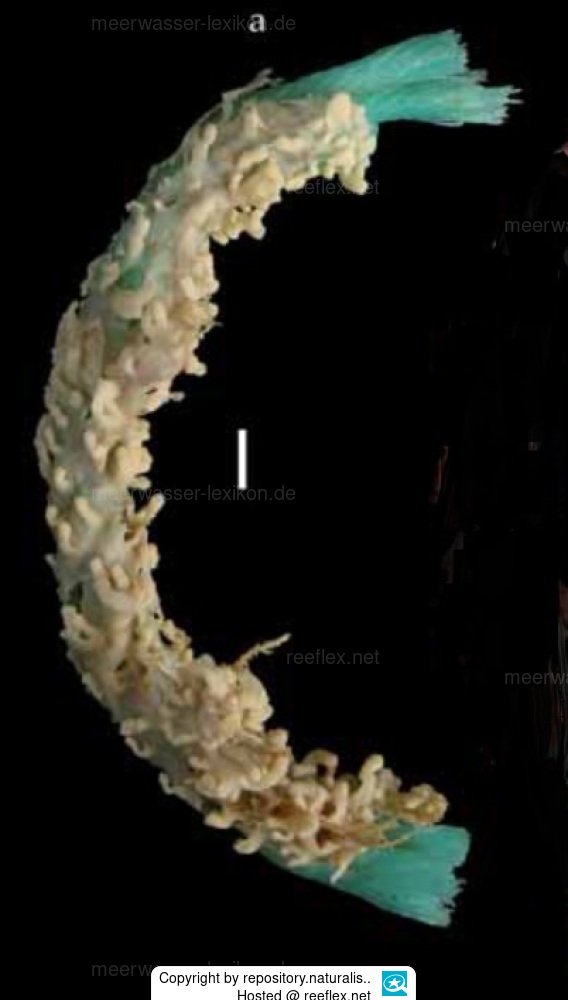Info
From the introduction of the paper "New and redescribed encrusting species of Alcyonium from the Atlantic Ocean (Octocorallia: Alcyonacea: Alcyoniidae)".
Four encrusting species of Alcyonium are known from the Atlantic Ocean:
Alcyonium coralloides (Pallas, 1766), Alcyonium grandiflorum (Tixier-Durivault & d'Hondt, 1975), Alcyonium maristenebrosi Stiasny, 1937, and Alcyonium senegalense Verseveldt & Ofwegen, 1992. material collected during CANCAP expeditions (see Van der Land, 1987) was examined. In addition, a specimen collected on the French CENTOB- cruise was also examined.
This material contained specimens of Alcyonium grandiflorum and Alcyonium maristenebrosi.
Three species new to science are also presented, all from depths of 1000 meters or more.
On an old lobster pot with about 500 meters of nylon rope, which was covered with numerous epizoans, a colony of the soft coral could be landed from about 1200 meters depth.
Further material was recovered during the "Tydeman" Cape Verde Islands Expedition 1986 from about 510 meters, the material was from a muddy sandy bottom with pteropods.
Colonies of Lateothela grandiflora occur abundantly in the waters around the Azores.
One colony has a series of side branches to which the colony encrusts dead gorgonian axes attached to the rope.
However, another colony grows only on the axis of a gorgonian.
The polyps are evenly distributed over the membrane and are 0.5 - 4.5 mm apart, the polyp calyces are 2-6 mm high, the expanded polyps are 1.5 - 4 mm long and 1 - 3 mm wide; the
tentacles are retracted.
Both colonies examined are whitish.
Similar species: Alcyonium megasclerum Stokvis & van Ofwegen, 2006.
Synonyms:
Alcyonium grandiflorum (Tixier-Durivault & d'Hondt, 1974).
Parerythropodium grandiflorum Tixier-Durivault & d'Hondt, 1974
Four encrusting species of Alcyonium are known from the Atlantic Ocean:
Alcyonium coralloides (Pallas, 1766), Alcyonium grandiflorum (Tixier-Durivault & d'Hondt, 1975), Alcyonium maristenebrosi Stiasny, 1937, and Alcyonium senegalense Verseveldt & Ofwegen, 1992. material collected during CANCAP expeditions (see Van der Land, 1987) was examined. In addition, a specimen collected on the French CENTOB- cruise was also examined.
This material contained specimens of Alcyonium grandiflorum and Alcyonium maristenebrosi.
Three species new to science are also presented, all from depths of 1000 meters or more.
On an old lobster pot with about 500 meters of nylon rope, which was covered with numerous epizoans, a colony of the soft coral could be landed from about 1200 meters depth.
Further material was recovered during the "Tydeman" Cape Verde Islands Expedition 1986 from about 510 meters, the material was from a muddy sandy bottom with pteropods.
Colonies of Lateothela grandiflora occur abundantly in the waters around the Azores.
One colony has a series of side branches to which the colony encrusts dead gorgonian axes attached to the rope.
However, another colony grows only on the axis of a gorgonian.
The polyps are evenly distributed over the membrane and are 0.5 - 4.5 mm apart, the polyp calyces are 2-6 mm high, the expanded polyps are 1.5 - 4 mm long and 1 - 3 mm wide; the
tentacles are retracted.
Both colonies examined are whitish.
Similar species: Alcyonium megasclerum Stokvis & van Ofwegen, 2006.
Synonyms:
Alcyonium grandiflorum (Tixier-Durivault & d'Hondt, 1974).
Parerythropodium grandiflorum Tixier-Durivault & d'Hondt, 1974







 repository.naturalis.
repository.naturalis.



